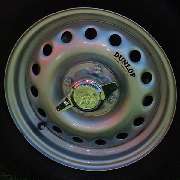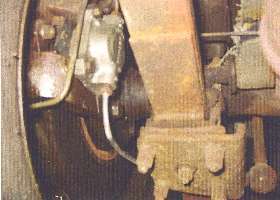| The MGA With An Attitude
MGA "DELUXE" - General Information - TC-103
The MGA "Deluxe" models may be thought of as a Twin Cam chassis carrying a pushrod engine. In outward appearance, both the Twin Cam and the "Deluxe" cars prominently display their knock off steel wheels, and four wheel disk brakes on closer inspection. Otherwise only three small badges are different (two on the font cowling and one on the boot lid), and the rest of the outer car body appears to be identical. There are significant variations in the internal body design, and the term "Deluxe" used as a model name may be a long term traditional misnomer, as the factory never referred to these cars as "Deluxe". Chassis features would be same as the Twin Cam for front brake hose bracket, starter switch bracket, clutch slave hose bracket, right side engine mount pedestal, five extra holes in the front frame cross member, and reversion to the standard front coil springs (due to difference in engine weight).
Existence of the "Deluxe" cars is a consequence of the factory bean counters pulling the plug on production of the Twin Cam model due to cost of excessive warranty claims on the Twin Cam engine. The factory would order parts for the Twin Cam cars 500 sets at a time. After the first 500 cars some minor changes were make to the body and chassis, most notable being addition of removable front inner wing access/vent panels and five holes in the front suspension cross member for access to the front sump bolts. When Twin Cam production ceased after 2111 cars, there were outstanding orders for Twin Cam parts up to 2500 cars, some parts in hand and some parts yet to be delivered, like a contract with Dunlop to supply a fixed number of the pin drive steel wheels. Production of the "Deluxe" was conceived to use up the remaining commitment for Twin Cam type chassis parts. In the end there would be about 360 "Deluxe" cars built. The remaining difference (29 shy of 500) may have been some parts shipped to distributors and dealers for warranty work or for inventory of service parts, or some parts procured as spares by competition privateers (and one Twin Cam chassis used by D.N. Stephenson to build the Panelcraft Twin Cam).


The "feature" of the Twin Cam chassis parts as applied to a pushrod engine car was simply called the "Competition Suspension" option, or alternately "All Round Disc Brakes" option. Since the Twin Cam chassis was rather more expensive, this option would add about 15% to the sticker price of the car. Later on other parts thought of as moderately expensive luxury options were commonly included with these cars as a package deal, possibly in an attempt to boost flagging sales of this model, and possibly to liquidate some inventory of other expensive parts. The pushrod engine cars with "competition suspension" were often fitted with the "Competition Deluxe Seats", close ratio gearbox, and/or an aluminum hardtop (even when normal 1600 roadsters were generally fitted with a fiberglass hardtop). The supply of aluminum hardtops would have been largely depleted (except for some dealer inventory) by the time the MGA 1600 MK II model was finished production, but factory records don't seem to differentiate between aluminum and fiberglass tops, and the other expensive options continued to be regularly installed. As such, these cars have been commonly referred to as "Deluxe" models, even though this name was not applied by the factory. These cars were apparently being marketed as competition cars as successor to the Twin Cam model.
Near the end of "Deluxe" production the cars would lose some of the Twin Cam unique features, like the inner fender access/vent panels and the extra 5 holes in the front cross member. For frames or bodies not yet produced it would be allowed to delete those features as not needed and cost reduction. It may be a challenge to determine exactly when the access panels and holes were deleted in production.
Construction of the "Deluxe" model always used a pushrod engine with the carburetors on the left, so these cars always had a heater (when fitted) with the air inlet on the right, and all of the normal body configuration in the heater shelf and firewall area to match (except for master cylinders). The steering rack was pressed forward (like the Twin Cam car, so it is presumed that all "Deluxe" cars used the same steering rack as the Twin Cam model with the long input shaft and the grease fittings on the bottom. The radiator used was the same as other pushrod cars, not the Twin Cam radiator. It had the filler neck and pressure cap on the radiator and no remote coolant tank, so the radiator and the associated mounting diaphragm on the body would be in the more rearward position common to other pushrod engine cars.
There were some "Deluxe" Coupes built, but not very many. Think of the Coupes being about 15% of total production, while they were being produced. Also think of Twin Cams being about 15% of production for the short time they were produced. Mix these in about equal proportion, and Twin Cam (or "Deluxe") Coupes may have been slightly more than 2% of total production in that time period. The "Deluxe" models were more rare than the Twin Cam cars. In the end, the rarest model of all would be the "Deluxe" Coupe. There are only 12 MGA 1600 "Deluxe" Coupe on record, and 38 MGA 1600 Mk II "Deluxe" Coupe. Production of the "Deluxe" cars spanned the change from 1600 to 1600-MK-II models. This led to the interesting fact that there would be four different and distinct body types produced to cover just 360 of the "Deluxe" cars, one body type for just 12 MGA 1600 "Deluxe" Coupe.
Just to pique your curiosity, there is a rumor that as many as perhaps three MGA 1500 "Deluxe" cars may have been built during the period of early production of the Twin Cam model. There appear to be no factory records of this, so I suspect that any existing 1500 "Deluxe" is most likely an aftermarket conversion to the 4-wheel disc brakes and knock-off pin drive steel wheels. As far as I know no one has yet claimed to be in possession of an original example. If anyone should happen to know of the existence of an original MGA 1500 "Deluxe" (not an aftermarket conversion), I would certainly like to hear about it.
|

